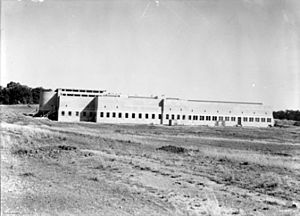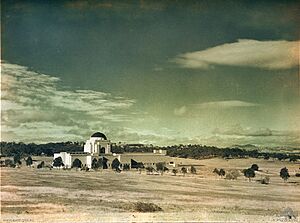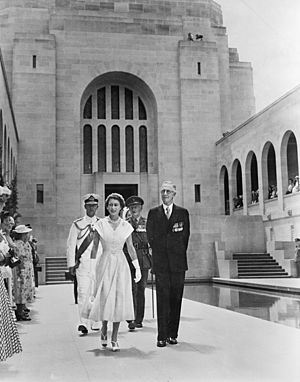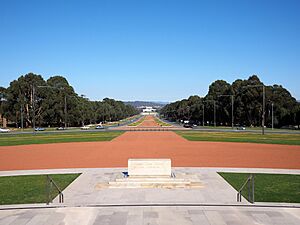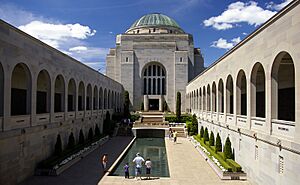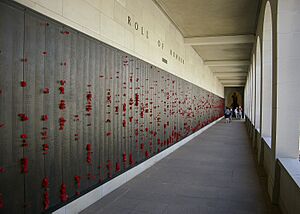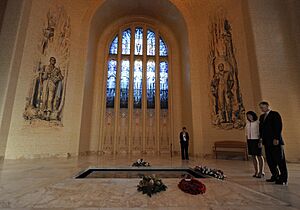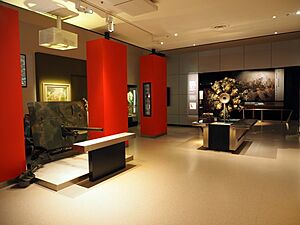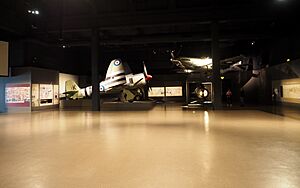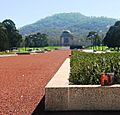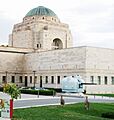Australian War Memorial facts for kids
Quick facts for kids Australian War Memorial |
|
|---|---|
| Australian Government | |
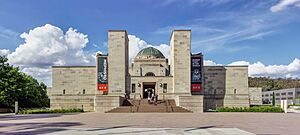
The Memorial Building from the central precinct of the Australian War Memorial, 2015
|
|
| For Australians who died as a result of war | |
| Established | 1925 |
| Unveiled | 1941 |
| Location | 35°16′50″S 149°08′57″E / 35.2805°S 149.1491°E |
| Designed by | Emil Sodersten and John Crust (Memorial Building) Denton Corker Marshall (Administration Building, ANZAC Hall, CEW Building) |
|
Unknowns
|
1 |
| Official name: Australian War Memorial, Anzac Pde, Campbell, ACT, Australia | |
| Type: | Listed place |
| Criteria: | A., B., D., E., F., G., H. |
| Designated: | 22 June 2004 |
| Reference #: | 105469 |
The Australian War Memorial (AWM) is a special place in Canberra, Australia's capital city. It is a war memorial and a museum. The AWM remembers all Australians who have died because of war. It is located in Campbell, a suburb of Canberra. The site has five buildings and a sculpture garden. Most of the museum's displays are inside the main Memorial Building.
Ideas for building this national memorial started after the First World War. The AWM was officially created by law in 1925. Emil Sodersten and John Crust designed the main building. Its construction was delayed by the Great Depression. Work picked up in the mid-1930s, and the AWM opened in 1941. Later, more buildings were added to hold new exhibits and offices. In 1993, the Tomb of the Unknown Australian Soldier was placed inside the Hall of Memory.
At first, the memorial only remembered those from the First World War. But its purpose grew over time. In 1939, it included those from the Second World War. By 1952, it covered Australians from all wars. In 1975, it expanded to remember all Australians who died in conflict.
The memorial and museum are open every day, except Christmas Day. The AWM holds special ceremonies. These include a nightly Last Post service. It also hosts national services for Anzac Day and Remembrance Day.
Contents
Why Was the Australian War Memorial Built?
The idea for a national war memorial came from Charles Bean in 1916. He was an official historian during the First World War. He wanted a place to remember veterans and show war trophies. The Australian Government supported his idea. They formed a committee in 1919.
Bean and John Treloar helped create the AWM. Treloar later became its first director. They believed the museum and memorial should be together. The museum would display war items.
How Was the Memorial Designed and Built?
In 1923, the government announced plans for the memorial. The AWM was officially set up by law in 1925. A competition was held for the design. But no single winner was chosen. Instead, Emil Sodersten and John Crust worked together. They combined Sodersten's Art Deco style with Crust's ideas to save money.
Construction was supposed to start in 1929. But the Great Depression caused delays. The project also became smaller due to a limited budget. By 1934, some work began again. A "Lone Pine" tree was planted. This tree grew from a seed brought from Gallipoli. By 1935, AWM staff started using parts of the building. The AWM officially opened on Remembrance Day in 1941.
Over the years, the AWM's role expanded. In 1939, it included those from the Second World War. In 1952, it covered all Australian wars. By 1975, it remembered all Australians who died because of war. This included those not serving in the armed forces.
In 1993, the Tomb of the Unknown Australian Soldier was placed at the AWM. From 1996 to 1999, the museum updated its displays. It also added space for temporary exhibits. In 2021, plans were approved for a major expansion. This includes new buildings and upgrades.
Who Has Led the AWM?
Many people have served as directors of the Australian War Memorial. The first director was J. L. Treloar, who served from 1920 to 1952. The current director is Matt Anderson, who started in 2020.
What Can You See at the Memorial Grounds?
The Australian War Memorial is in Campbell, a suburb of Canberra. It sits at the base of Mount Ainslie. The memorial is at one end of Anzac Parade. This road lines up with the center of Canberra's design. This special position shows its national importance. It also gives a clear view to Parliament House.
The entire AWM is listed on Australia's Commonwealth Heritage List. This means it is a very important place. Next to the AWM is Remembrance Nature Park. This park is part of the Remembrance Driveway. This driveway connects Sydney and Canberra. It remembers Australians who received the Victoria Cross in World War II and the Vietnam War.

The southern part of the AWM grounds is the Parade Ground. Here you will find the Stone of Remembrance. This large stone is a main spot for ceremonies. It was moved here in 1962. The Parade Ground was updated in 2004. This made it better for special events.
The AWM has several buildings. These include the Memorial Building, ANZAC Hall, the CEW Bean Building, and the Administration Building. There is also a cafe. The Memorial Building opened in 1941. It holds the main memorial and exhibition areas. The Administration Building opened in 1988 for offices. ANZAC Hall opened in 2001. It is a large space for big exhibits like planes. The CEW Bean Building opened in 2006. It holds more offices and collection items. Poppy's Café opened in the early 2010s.
The newer buildings, like ANZAC Hall, were designed by Denton Corker Marshall. They were built in lower areas. This makes them sit below the main Memorial Building. ANZAC Hall is designed to look like a battleship. Its walls and roof are shaped to resemble a ship's turret.
The Memorial Building: What's Inside?
The Memorial Building is the main part of the AWM. It has the memorial areas and most of the museum galleries. It also has a research center and a museum shop. The building was designed in the 1930s. It officially opened on November 11, 1941. Two more wings were added later, from 1968 to 1971.
The building has an Art Deco style. This was a popular design in Canberra at the time. It also has some Byzantine and Egyptian influences. These can be seen in its shapes and tall pillars at the front.
In 1937, Napier Waller was asked to create large murals and mosaics for the building. Leslie Bowles was asked to design a large sculpture. After Bowles' death, Ray Ewers finished his sculpture. Ewers' final design, Australian Serviceman, was accepted in 1955. Waller's mosaics were also installed in 1955. His murals are the largest in Australia.
Places to Remember and Reflect
The memorial area includes the courtyard and the Hall of Memory. These are right after the main entrance. The courtyard has a reflecting pool. Steps lead from the pool to the Hall of Memory. The courtyard walls have arches. Behind these arches are the Roll of Honour panels.
The Roll of Honour lists the names of over 102,000 Australians. These are people killed in war, from the Mahdist War to the War in Afghanistan. The panels were first installed in 1961 for World War I. More panels were added later for other conflicts. No rank is shown with the names. This is because everyone who died is remembered equally.
The courtyard also has 26 carved stone figures. These show Australian animals and Indigenous people. These carvings were replaced in the 2010s because they wore out. In 1988, an eternal flame was added to the reflecting pool.
The Hall of Memory is under the building's dome. The dome represents rising to heaven. Inside, you will find the Tomb of the Unknown Australian Soldier. Four tall pillars designed by Janet Laurence stand behind the Tomb. These pillars represent air, earth, fire, and water.
The Hall also has beautiful stained glass windows and mosaics. These were designed by Waller. They show Australia's armed services. Over six million glass tiles from Italy were used for the mosaics. They show an airman, sailor, servicewoman, and soldier.
Museum Galleries: Exploring History
The museum galleries are on the lower levels of the Memorial Building. They surround the memorial areas. Many galleries are organized by specific wars. For example, there is a First World War gallery and a Second World War gallery.
Other galleries cover different topics. These include the Colonial Conflict gallery and the Conflicts 1945 to Today gallery. There is also the Aircraft Hall and the Hall of Valour. Many galleries use dioramas. These are 3D scenes that show moments from history. Most dioramas are in the First and Second World War galleries.
The First and Second World War galleries are connected. The Second World War gallery was updated in the late 1990s. The First World War gallery was updated in 2014. The Sinai and Palestine area in the First World War gallery still has many of its original features.
Newer galleries include the Aircraft Hall and the Conflicts 1945 to Today Gallery. These were added in the late 1990s and 2000s.
The Hall of Valour is another important gallery. It is located below the Hall of Memory. This gallery honors Australians who received the Victoria Cross and George Cross. The AWM has the largest public collection of Victoria Cross medals in the world. It includes 76 of the 101 Victoria Crosses given to Australians. This includes all nine awarded at Gallipoli.
Sculpture Garden: Art and Remembrance

The western part of the AWM grounds became a sculpture garden in 1999. The first sculpture placed here was Ewers' Australian Serviceman statue. It was moved from the Hall of Memory. As of 2022, there are 25 memorials or sculptures in the garden. More than 150 plaques are also found in the gardens. These plaques remember different military units.
Commemorative Services: Honoring the Fallen

The Australian War Memorial holds special ceremonies. These include a nightly Last Post service. It also hosts two national services each year for Anzac Day and Remembrance Day.
The Last Post Ceremony
The Last Post ceremony started in 2013. It happens every day at 4:45 PM. The ceremony begins with the Australian National Anthem. Then, a piper plays music. Visitors can lay wreaths and flowers by the reflecting pool. A volunteer from the Australian Defence Force reads a story. This story is about an individual listed on the Roll of Honour. The ceremony ends with the sounding of the Last Post. It usually lasts less than 30 minutes.
Where Are Other Items Stored?
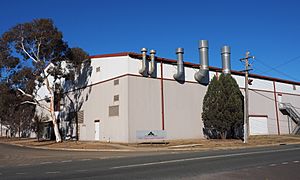
Only a small part of the AWM's collection is on display. The rest is stored at the Treloar Resource Centre. This facility is in Mitchell, Canberra. It also has workshops for restoring items. Sometimes, the facility opens to the public for special "Big Things in Store" days.
Publications: Sharing Stories
The memorial helped create the official histories for World War I, World War II, Korea, and Vietnam. It also publishes a quarterly magazine called Wartime. This magazine features images from the collection. It also has articles by historians. The magazine focuses on Australia's experience of war. The first issue was published in 1997.
The memorial also used to publish a journal. It was called The Journal of the Australian War Memorial. It stopped publishing in 2003, but a final issue came out in 2007.
Images for kids
-
Diorama of the Battle of Magdhaba
-
Monument to Simpson and his Donkey
-
Kangaroos in front of a naval gun. The domed structure in the background is the Hall of Memory.
-
Anzac Day 90th anniversary Dawn Service (25 April 2005)
-
Dawn Service, 25 April 2013. The crowd of around 35,000 people was addressed by Cpl Ben Roberts-Smith VC MG who read stories and anecdotes from Australian service men and women relating to the war in Afghanistan.
See also
 In Spanish: Memorial de Guerra Australiano para niños
In Spanish: Memorial de Guerra Australiano para niños
- List of Australian military memorials
- List of Korean War memorials
- List of military museums
- Lists of war monuments and memorials
- World War I memorials


